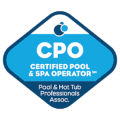Safety
Make Your Pool/Spa Area Safer for Children
Drowning Prevention information is not “for someone else”.

It is for you. Because only by increased awareness and effort can we reduce some very alarming statistics. Drowning is one of the largest causes of accidental death for American infants and children under the age of five. This page contains tips on how to help prevent these unfortunate accidents. Read on and learn how you can help make your pool or spa area safer for children.
Drowning Prevention Tips
- Pools and spas are attractive to children, and children must be kept away from them in the absence of adequate supervision. A fence, wall or natural/artificial barrier should completely enclose your pool or spa. All gates or doors with access to the pool or spa should have a spring lock, self-closing and self-latching mechanism that protects against unauthorized entry and use. (The inside latch should be above the reach of toddlers or young children.)
- If your pool, spa or hot tub is indoors, lock the door to the room or have a cover that locks, to keep out children and other unauthorized users.
- Do not place objects (e.g., chairs or tables) near the pool or spa fence that would allow a youngster to climb over. Tree limbs and low overhanging roofs should be removed or made inaccessible.
- A float line stretched across a pool indicating where the deep end begins can avoid a dangerous excursion by young children into water over their heads.
- A clear view of the pool or spa from the house should be assured by removing vegetation and other obstacles. Trespassers or unexpected swimmers can be discovered by an occasional glance at the pool or spa area.
- Reaching and throwing aids should be kept on both sides of the pool. These items should remain stationary and not be misplaced through play activities.
- Pools or spas should never be used if any of the grate outlets are missing or broken.
- If you use a pool or spa cover, carefully read and follow the manufacturer’s directions for safe installation, use and maintenance. Always completely remove the cover before using your pool or spa, to avoid the possibility of anyone – especially a small child — being trapped and drowning under the cover. Drain any standing water from the surface of your pool or spa cover. An infant or small child can drown even in the smallest amount of water. Be especially alert for the potential for drowning accidents if you use any of the lightweight, floating pool or spa covers. These floating covers are not solid and no one can crawl or walk on them. They are not for safety.
Safety Tips
- During social gatherings, be certain that someone has the major responsibility for watching the children and swimmers at all times.
- Never leave a child alone out of eye contact supervision in or near the pool or spa – not even for a second.
- Young children should never be considered water safe despite their swimming skills, previous instruction or experience.
- Access to the pool or spa should be limited by locked doors or gates whenever swimming or soaking cannot be supervised.
- Teach your children good pool or spa safety habits: no running, pushing playmates, no jumping on others, no diving or jumping in shallow water or “dunking”.
- Do not rely solely on plastic inner tubes, inflatable arm bands or other toys to prevent accidents.
- Keep toys, particularly tricycles or wheel toys, away from the pool or spa. A child paying with these could accidentally fall into the water.
- Do not allow anyone of any age to swim without a “spotter” nearby. Examples of good safety behavior by adults are important for young children.
- Do not permit playful screaming for help (false alarms) which might mask a real emergency.
- Teach your children the most effective way to get out of the pool or spa quickly.
- Do not allow your child to swim immediately after eating a heavy meal.
- Do not allow swimming during thunder or other storms.
- Do not allow glass in the pool or spa area.
- Do not allow the use of drugs or alcohol by persons using the pool or spa, or in the pool or spa area.
Prepare for an Emergency
Poolside rescue equipment, including a ring buoy with an attached line and/or a long handled hook, should be available to assist in removing victims from the water. This equipment should never be used for play.
Emergency procedures should be clearly written and posted in the pool area.
Adults in the family should be trained in cardiopulmonary resuscitation (CPR). CPR is the combination of rescue breathing and artificial circulation for victims or respiratory or cardiac arrest as a result of drowning, heart attack or other causes. CPR training is available through local chapters of the American Red Cross or the American Heart Association.
In case of emergency:
- Dial the local emergency telephone number 911 (or the appropriate 7-digit number for emergency Medical Service (EMS), Fire or Police). It is advisable to install a telephone (or use a cordless telephone) in the pool or spa area.
- Give your name, location, and telephone number you are calling from.
- Tell what happened and how many people need help.
- Don’t hang up the phone until after the emergency person does.
Preventing an emergency is the best preparation: Never leave a child alone in or near a pool, spa or any other body of water!!
Take special precautions with young children who use spas. Spas are deep enough for children to drown in a matter of minutes. Also, children may become ill from overheating.







